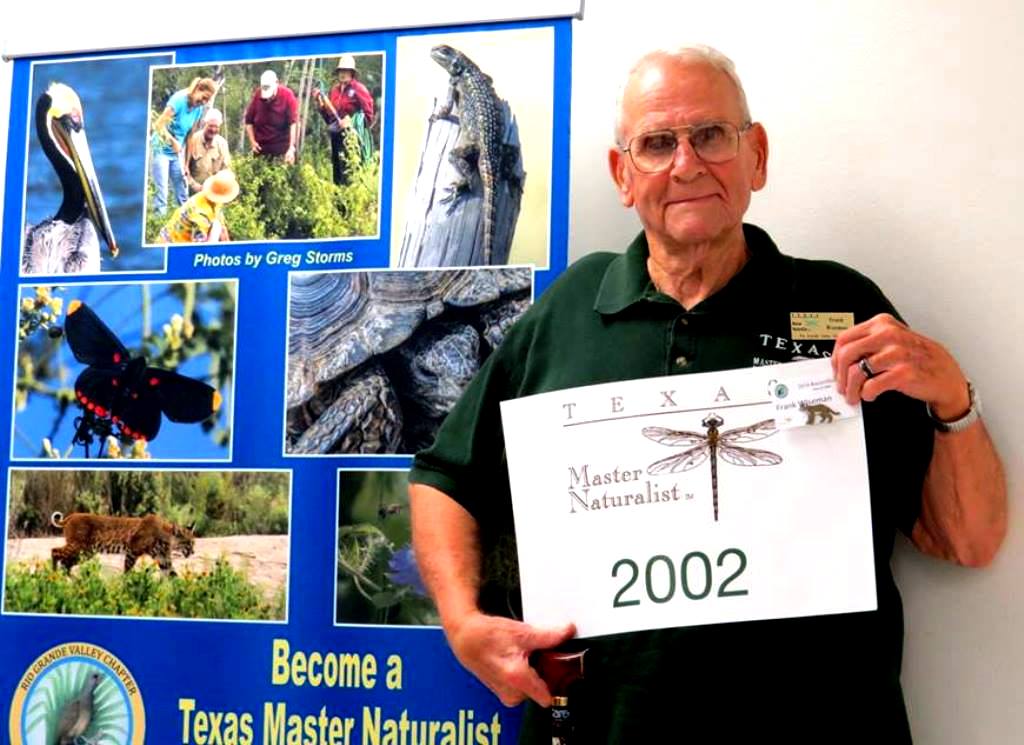by Pat Avery

Spread your wings! That’s the take-away message from a man who taught us by example!
All members of an organization can benefit from learning its history. Frank Wiseman, one of the founding members of the RGV Chapter, willingly shared our beginnings.

We started the first class with twenty-five trainees in 2002. Tony Reisinger and Jesus Franco were our sponsors. Jesus developed the class schedule and field trips. Tony oversaw the organizational process.
We chose officers based on our individual backgrounds. I became secretary because of my experience with the Arroyo Colorado Audubon Society (ACAS). We held board meetings at my home. Later I served as vice-president and president.
The state TMN furnished no rules or regulations for several years so each chapter functioned on its own. Frank wrote the by-laws and the operating handbook, as well as completing and filing all the paperwork for the chapter’s 501c3 approval. The state has never furnished any funding to the chapters. They are all self-supporting.

The chapter needed money to rent the Harlingen Library conference room for general meetings. They began fundraising activities including reselling local native nurseryman Mike Heep’s native plants and holding an annual raffle. The first three raffles included a grand prize of a free butterfly garden in the winner’s yard. By 2004, they raised enough to buy their first computer.
Frank and Christina Mild, newsletter editor for ACAS and honorary RGVC TMN member, organized native plant field trips across the Valley in 2002 to qualify for the required advanced training. They were often accompanied Dr. Alfred Richardson and Ken King, co-authors of Plants of Deep South Texas, on their research trips.
Frank taught native plant training classes and gave presentations throughout the Valley.

The Arroyo Colorado Audubon Society had adopted Harlingen’s Hugh Ramsey Nature Park as its project. Because several of their members also joined the RGVC TMN they began to share in the project. They began with one area of the park on the south side, around the trail named Ebony Loop, developing the Betty McEnery Garden and eventually took over the south side. Once the city agreed to put water around the Ebony Loop, they began establishing specialty native plant garden areas, such as Robert Runyon Garden and Butterfly Meadow, with a group called the Tuesday-Thursday TMN volunteers.

In 2005, the chapter established the Robert Runyon Garden in honor of Runyon, a self-taught biologist and well-known botanist. He had served as a war photographer in the Mexican Revolution and later became active in Brownsville politics. In 1929, Runyon discovered a tree, the Esenbeckia runyonii. The chapter planted one of the trees in the Runyon garden.
For more information on Robert Runyon and the tree, see (https://www.tamuk.edu/artsci/departments/biol/research/limoncillo.html).
Frank led the development of other volunteer opportunities including Hawk Watches at Santa Ana National Wildlife Refuge, work days in many parks, holding several yearly Saturday fairs at Sabal Palms and rescuing native plants across the Valley, which were added to Ramsey Park. The board made a decision to work on a native plant garden at the Nature Conservancy in Brownsville and later set up advance training opportunities with Sea Turtle, Inc., which led to volunteer opportunities including the Turtle Patrol and beach cleanups.
Frank served as a photographer for most of the volunteer work, chronicling the chapter’s work for the website and later on the Friends of Hugh Ramsey Nature Park Facebook page.
He is a perfect example of members who make a difference. In 2017, the state organization recognized him for achieving 5,000 volunteer hours.
So how does one go from an ordinary childhood to a life of service? Frank was born in Port Isabel in 1933, the year of a hurricane (the 1933 Cuba-Brownsville Hurricane) that caused his mother to move with her young children to Brownsville. His father, who worked for John Shary, a well-known developer in the Port Isabel area, stayed behind. By the time he started school, the family had moved to La Feria. After graduating from high school, he earned a degree in languages from the University of Texas.
The U.S. Army invited Frank, via the draft, to spend a couple of years in Korea, where he served at Camp Casey. After he returned home, he taught in Falfurrias. Then he joined the United States Air Force Dependents school system and spent the next twenty years teaching Spanish, English and French in Europe; five in England and fifteen in Spain.
While in Madrid, Spain, Frank earned his first Masters degree in Guidance and Counseling. Upon returning home, he earned a second in Education at Pan American in Edinburg.
When I asked his advice for those of us following in his footsteps, he stated it simply and to the point.

Love what you’re doing.
Spread your wings into two or three areas.
Volunteer, be with other people and share the knowledge you gather along the way.
Most of all, don’t keep your learning to yourself. Teach – in any and every way you can.
Share your special gift – your love of nature.
Realizing this interview only touched the surface, Frank sent additional information for those interested in a better understanding of our history. Stay tuned for those stories.




Leave a Reply